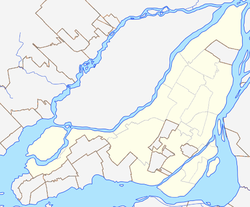Pointe-Saint-Charles
| Pointe-Saint-Charles | |
|---|---|
| Neighbourhood | |
| Location of Pointe-Saint-Charles in Montreal | |
| Coordinates: 45°28′52.3″N 73°33′11.2″W / 45.481194°N 73.553111°WCoordinates: 45°28′52.3″N 73°33′11.2″W / 45.481194°N 73.553111°W | |
| Country | Canada |
| Province | Quebec |
| City | Montreal |
| Borough | Le Sud-Ouest |
| Established | 1668 |
| Population (2011) | |
| • Total | 13,731 |
Pointe-Saint-Charles (also known locally as simply The Point) is a neighborhood in the borough of Le Sud-Ouest in the city of Montreal, Quebec, Canada. Historically a working-class area, the creation of many new housing units, the recycling of industrial buildings into business incubators, lofts, and condos, the 2002 re-opening of the canal as a recreation and tourism area, the improvement of public spaces, and heritage enhancement have all helped transform the neighborhood and attract new residents. Community groups continue to be pro-active in areas related to the fight against poverty and the improvement of living conditions.
Twenty years after the founding of Ville-Marie (Montreal) by Paul Chomedey, Sieur de Maisonneuve in 1642, he granted an area on the pointe Saint-Charles, extending into the St. Lawrence, to St. Marguerite Bourgeoys for agricultural use by the Congrégation de Notre-Dame. The sisters operated a sharecropping farm (métairie) on the land. From an area of about 30 arpents (about 10 hectares), the farm reached an area of 200 arpents (about 68 hectares) by the mid-18th century. The nuns built the Maison Saint-Gabriel, the only remaining trace of their farm and one of the oldest buildings in Montreal, on their property in 1698. Their farming activity only ceased altogether in the 1950s.
Until the mid-19th century, the area was chiefly agricultural. Urbanization began with the enlargement of the Lachine Canal (completed in 1848), as the transportation access and water power attracted industry to the whole of what is now the Sud-Ouest borough. The installation of railways and the construction of the Victoria Bridge (1854–1860) also attracted workers and spurred development. The then-owners, the Sulpician Order, divided the area into lots and auctioned them off starting in 1853, with the Grand Trunk Railway purchasing a large area for use as a railyard.
...
Wikipedia

